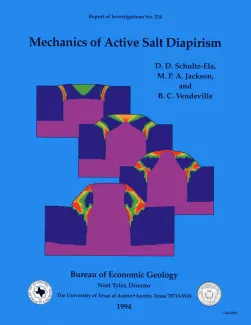
Publication Details
Get the Publication
$11.50
Abstract/Description:
An active diapir forcefully intrudes its overburden, driven by diapir pressure that overcomes the resistance of the overburden strength. Possible causes of the driving pressure are differential loading of the source layer and a density contrast with the overburden. Resisting forces derive from the mass of the roof block and resistance to the faulting and folding that accommodate the intrusion. This report describes the evolution of active diapirs and development of structures in their rock on the basis of analytical, physical, and numerical modeling.For a typical density contrast between salt and a sedimentary overburden, a simple force balance demonstrates that the diapir height must be more than two-thirds to three-quarters the thickness of the surrounding overburden to initiate substantial active diapirism. Diapirs with widths less than the regional overburden thickness must be even taller to initiate active diapirism. Physical and numerical models show that typical structures of active diapirism are a central crestal graben flanked by relatively unstrained flaps that rotate upward and outward. Curved reverse faults can separate the flaps from the regional overburden. Normal faults in the crestal graben propagate downward, new faults being created farther outward as the roof arches over the rising diapir. Thin, wide roofs develop multiple grabens separating a relatively flat roof from the rotating flaps. In models leading to emergence, the piercing diapir evolves from a pointed crest to a progressively rounding and widening crest as the flaps rotate outward. Our numerical models show that overburden flexure contributes to early formation of active diapir structures, but piercement does not continue to emergence unless the diapir is very wide or tall relative to the overburden thickness. Active diapirism becomes progressively more difficult for diapir crests having the following shapes: rectangle (least difficult), round-cornered rectangle, semicircle, and triangle with a pointed crest (most difficult).